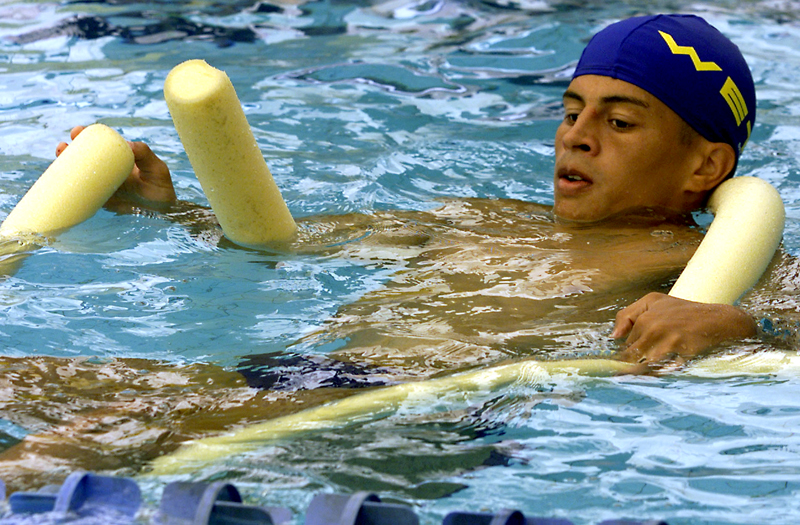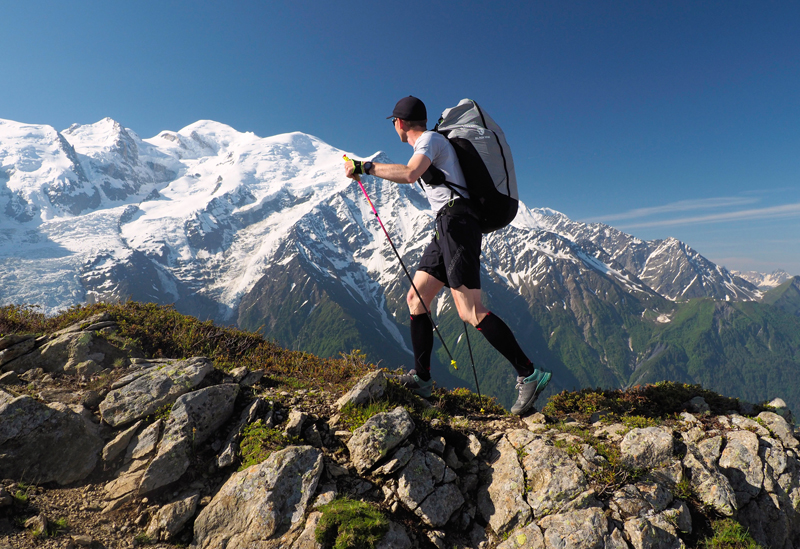Recovery and injury rehab: harnessing water power!

It might look uninspiring, but water is actually a truly remarkable substance. It’s not just that it comprises over two thirds of your bodyweight, its unique chemistry also gives it exactly the right properties to enable our cells to perform the hundreds of thousands of biochemical reactions needed to sustain life itself. However, the benefits of water to humans go beyond those derived from internal consumption. Since time immemorial, doctors and physicians have used the healing power of water applied externally to their patients, more commonly known as ‘hydrotherapy’.
Water for athletes
More recently, the therapeutic properties of water have found favour with coaches and physiotherapists, looking to help athletes recover from both acute and chronic injuries as well as preventative conditioning. Just a few examples include hydrotherapy use in order to speed up return to sport after arthroscopic hip surgery in injured volleyball athletes(1), hydrotherapy to help rehabilitate chronic back lower back pain(2), hydrotherapy to help athletes recover from ankle sprain and chronic ankle instability(3), hydrotherapy for anterior cruciate ligament (knee) injury recovery(4) and many more.
Hydrotherapy is not just a proven method for helping speed up recovery following injury; there are also numerous studies showing that it can be used as an effective, low-impact training mode in its own right - ideal for athletes who may be injury free but vulnerable to re-injury. A systematic review study (one that draws together all the existing data on a topic to arrive at an overall conclusion) published just last month found that high-intensity interval sessions based on land-type exercises (eg sprints) but performed in an aquatic environment were very effective in building cardiovascular and metabolic fitness in those who had musculoskeletal conditions, and therefore were unable to carry out the equivalent land exercises(5).
Another systematic review study published last year found that deep water running proved just as effective at building cardiorespiratory fitness as land running, but without the high-impact loading that can precipitate running-related injuries in vulnerable runners(6) Therefore, if you’re a land-based athlete who is either injured, trying to stay uninjured, or just looking for some variety in your workouts, maybe it’s time to get yourself down to the local pool!
The four key properties of water
Once you leave dry land and immerse yourself in water, you are surrounded by a very different environment. In particular, there are four key physical properties of water (or the effects exerted on a body immersed in it) that endow it with its potentially healing powers. These are buoyancy, viscosity, hydrostatic pressure and heat conductivity. Let’s take each of these in turn:
· Buoyancy arises because when we stand in a pool, the volume of the body below the waterline has to displace an identical volume of water above the waterline. This is the same effect (Archimedes Principle) you observe when you get in your bath and the water level rises – it rises by an equivalent volume to the volume of your body below the water. However, the water you displace upwards has to rise against gravity. This weight of water then ‘pushes’ back down exerting an equal and opposite force against your body weight, effectively reducing the gravitational pull against your body weight. In simple terms, the deeper the water you stand in, the more water you displace, the less your body is affected by gravity and the more buoyant you become.
· Viscosity is the property that causes friction and resistance when you move through water. All liquids and gases have viscosity but the higher the viscosity, the more resistance an object experiences while trying to move through that liquid or gas. The viscosity of air is very low, which explains why you can run along at 12mph, without too much air resistance. The viscosity of water on the other hand is very high being 60 times greater than air – even wading through waist deep water at 3mph is hard work.
· Hydrostatic pressure arises from the fact that water pressure increases proportionally with depth. The deeper below the surface of the water you are, the more weight of water is piled up above you and the more pressure you experience. For each metre under the water surface, the pressure increases by around 60mm of mercury. Standing in water up to your neck, you ankles are experiencing a hydrostatic water pressure of around 100mm Hg, enough to exceed the circulatory diastolic pressure (more later).
· Heat conductivity simply describes the ability of a substance to remove heat from an object when it comes into contact with that object. The conductivity of water is very high, so it is effective at removing heat from the body.
Injury rehabilitation generally involves promoting muscular and/or cardiovascular conditioning without excessive loading or stressing of certain muscles and joints and when you consider the physical properties of water described above, it’s easy to see why aquatic therapy is so beneficial. Take buoyancy for example. Standing in water up to your waist reduces your effective bodyweight by 50%. Wading in deeper so that your shoulders are submerged effectively reduces the weight to around 10% of your land mass. Knee, ankle or hamstring running injuries are difficult to rehabilitate on land because of the weight bearing and impact caused by gravity. But in a pool, you can perform your jogging or running action with much reduced loading, allowing the muscles to move through their correct range of movement in a fairly-stress free environment. As the injury improves, you can gradually move into shallower waters, thereby allowing the joints and muscles to adapt gradually to the effects of increasing amounts of gravity.
Hydrostatic pressure is also hugely beneficial. Because pressure increases proportionally with water depth, the deeper you stand in water, the greater the pressure exerted on your body. This causes a ‘centralisation’ of blood flow, which counteracts the tendency of blood to pool in the lower extremities such as injured ankles and knees(7). Theoretically, if the hydrostatic pressure exerted on a limb exceeds diastolic blood pressure in that limb, swelling should decrease when submerged at an appropriate depth. At approximately five feet of depth, the hydrostatic pressure is great enough to substantially exceed an athlete’s diastolic pressure and a reduction in swelling should occur even in warm water temperatures of up to 92° F.
The heat conductivity of water is also important in reducing swelling. A swollen ankle surrounded by air at 82 degrees F has very little heat conducted away because air is a poor conductor of heat. However, the thermal conductivity of liquid water is about 25 times that of air(8). Therefore, water is a very good heat conductor, and even at 82F (typical pool temperatures) sufficient heat can be removed from an injured area to reduce swelling. Finally the high viscosity of water means that you don’t need to perform potentially re-injuring fast and ballistic movements to get a training effect - even gentle movements through the water can produce plenty of resistance and significantly raise your heart rate.
Figure 1: Aqualogix Hybrid Training Fins*
You need to be logged in to continue reading.
Please register for limited access or take a 30-day risk-free trial of Sports Performance Bulletin to experience the full benefits of a subscription. TAKE A RISK-FREE TRIAL
TAKE A RISK-FREE TRIAL
Newsletter Sign Up
Testimonials
Dr. Alexandra Fandetti-Robin, Back & Body Chiropractic
Elspeth Cowell MSCh DpodM SRCh HCPC reg
William Hunter, Nuffield Health
Newsletter Sign Up
Coaches Testimonials
Dr. Alexandra Fandetti-Robin, Back & Body Chiropractic
Elspeth Cowell MSCh DpodM SRCh HCPC reg
William Hunter, Nuffield Health
Keep up with latest sports science research and apply it to maximize performance
Today you have the chance to join a group of athletes, and sports coaches/trainers who all have something special in common...
They use the latest research to improve performance for themselves and their clients - both athletes and sports teams - with help from global specialists in the fields of sports science, sports medicine and sports psychology.
They do this by reading Sports Performance Bulletin, an easy-to-digest but serious-minded journal dedicated to high performance sports. SPB offers a wealth of information and insight into the latest research, in an easily-accessible and understood format, along with a wealth of practical recommendations.
*includes 3 coaching manuals
Get Inspired
All the latest techniques and approaches
Sports Performance Bulletin helps dedicated endurance athletes improve their performance. Sense-checking the latest sports science research, and sourcing evidence and case studies to support findings, Sports Performance Bulletin turns proven insights into easily digestible practical advice. Supporting athletes, coaches and professionals who wish to ensure their guidance and programmes are kept right up to date and based on credible science.









